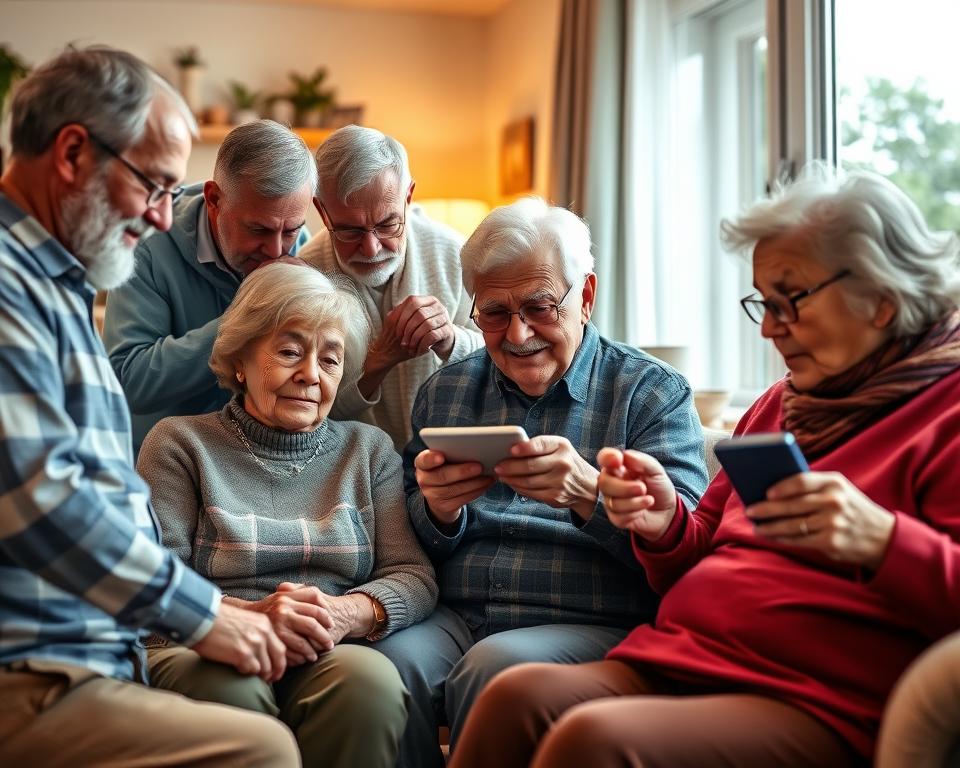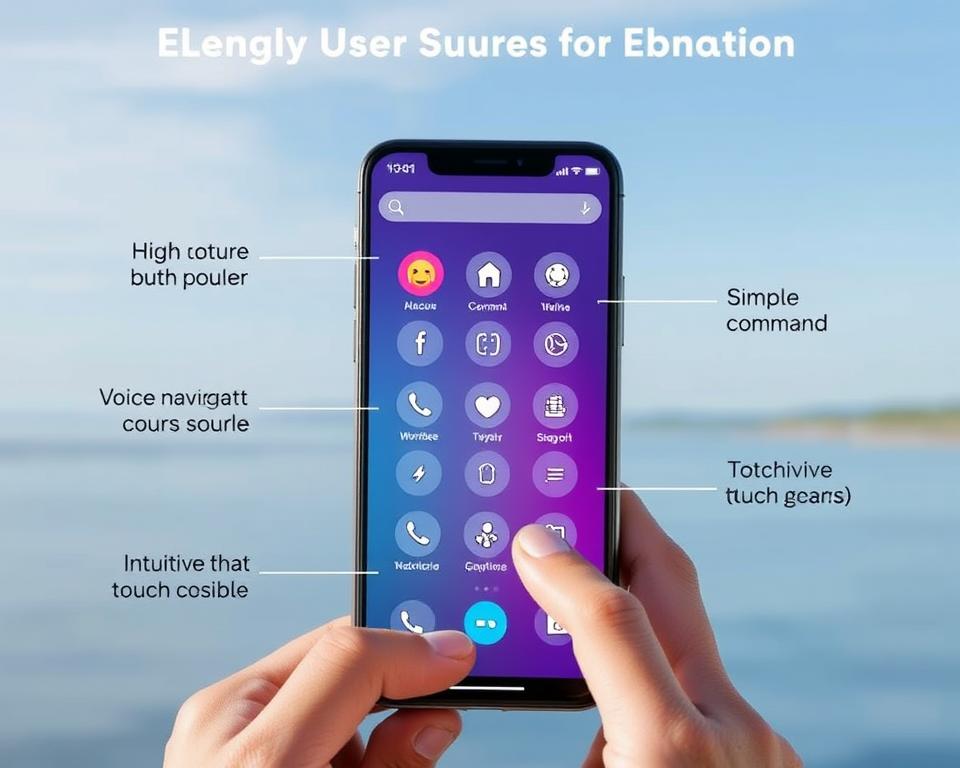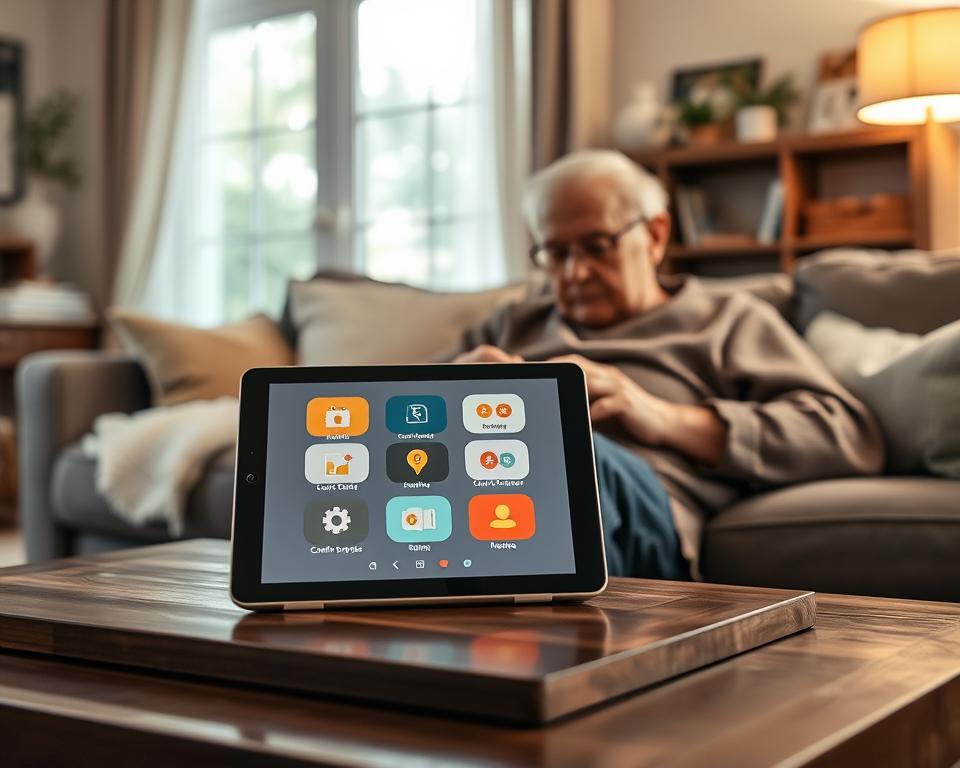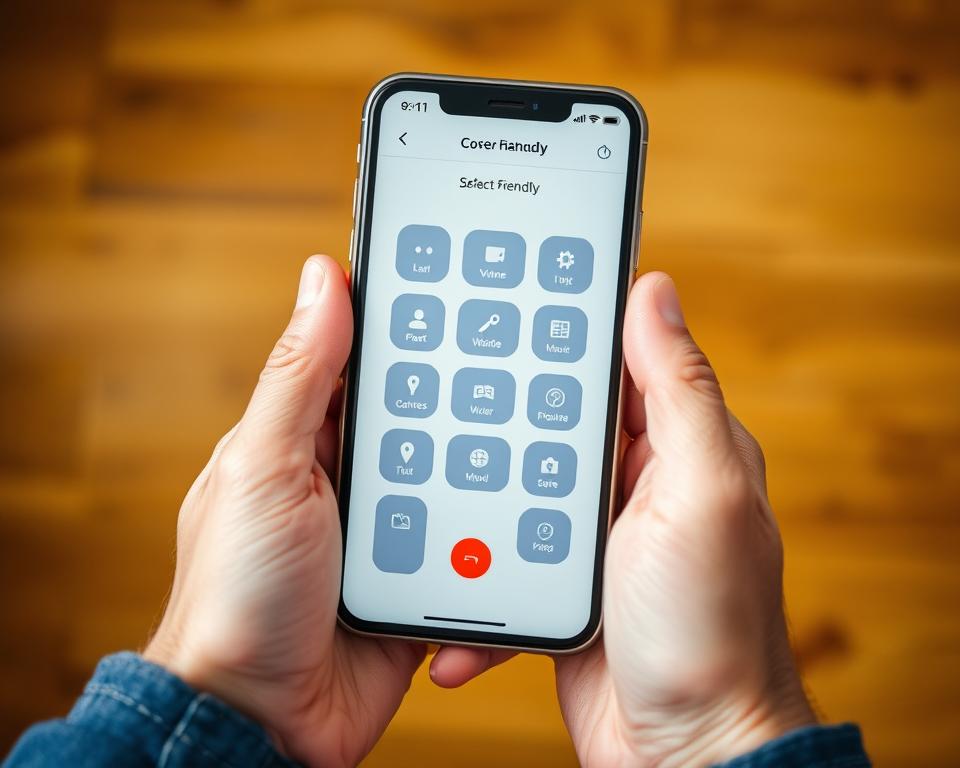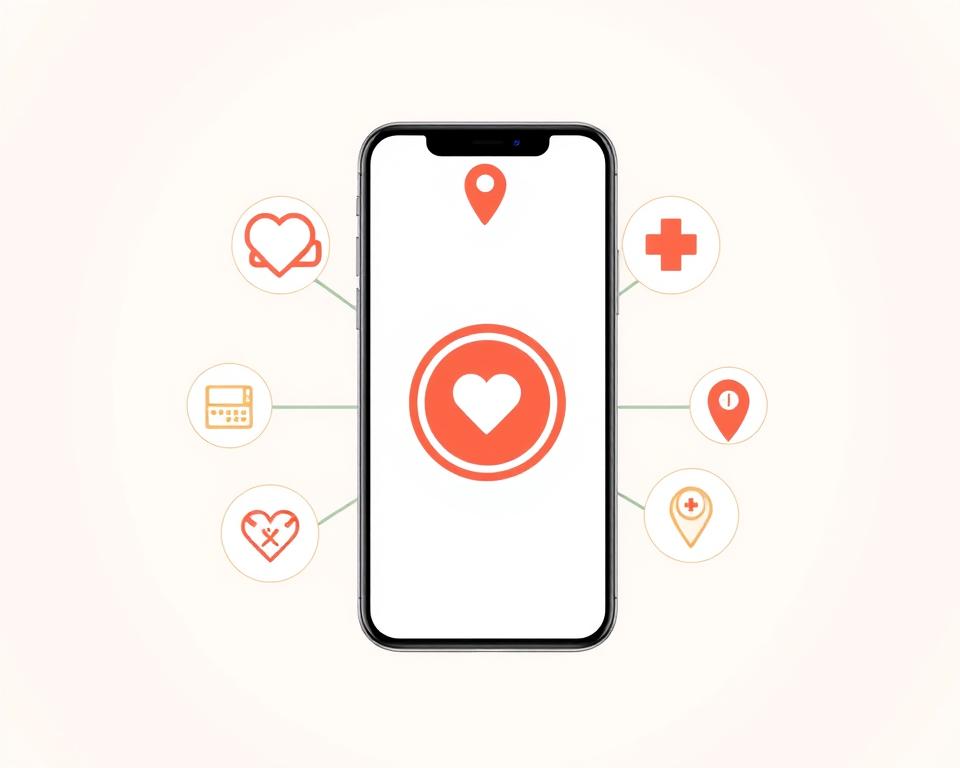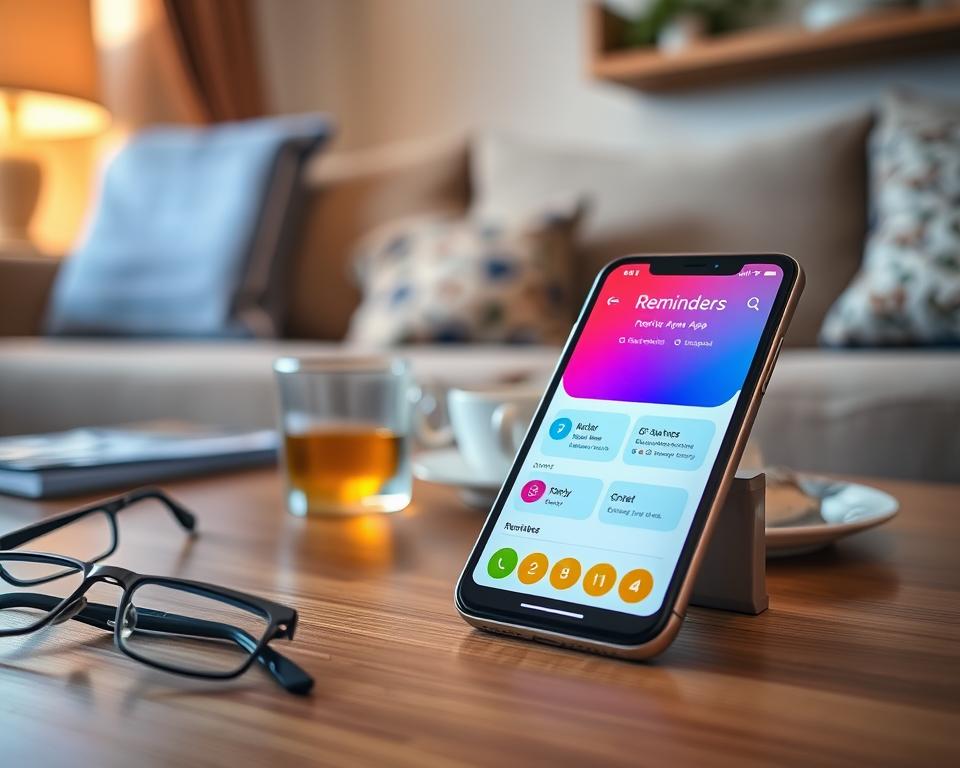The number of seniors is growing fast. This means more need for apps made just for them. Making apps for older adults needs a good grasp of their tech likes, physical limits, and digital hurdles. This article will show you how to make apps that are easy to use, simple to navigate, and meet the main needs of seniors.
Table of Contents
Key Takeaways
- Understand the demographic and digital needs of senior users to inform app design.
- Implement essential accessibility features, such as large text, high color contrast, and simplified navigation.
- Optimize app performance for older devices and integrate voice commands, emergency response, and memory assistance features.
- Prioritize social connectivity, community integration, and quality assurance testing to ensure a seamless user experience.
- Develop a long-term strategy for app maintenance and support to meet the evolving needs of elderly users.
Understanding the Senior User Demographics and Their Digital Needs
As the world’s population ages, it’s vital to meet the special needs of seniors with digital tech. Seniors, aged 65 and up, are growing fast. Knowing their physical and tech challenges helps make apps that fit their needs.
Age-Related Physical Limitations
Older adults deal with physical and mental changes that affect tech use. These include diminished vision, hearing loss, reduced dexterity, and cognitive decline. It’s important to make digital tools easy for seniors to use.
Technology Adoption Patterns Among Seniors
Seniors tend to adopt tech less than younger people. Their comfort with digital tools and access to devices matter. Knowing this helps make apps that seniors can use and enjoy.
Common Digital Challenges Faced by Elderly Users
Seniors face many digital hurdles, like complex interfaces, small touch targets, and audio or visual issues. Understanding these problems helps create apps that are easy and fun for seniors.
“Designing for the elderly means designing for all.”
– Elisa Spitz, Gerontology Researcher
By grasping the needs and challenges of seniors, app makers can create empowering tools. This way, they can engage and support this growing group.
Essential Accessibility Features for Senior-Friendly Apps
Creating mobile apps for older users is key for digital inclusion. Senior-friendly apps need special features to make them easy to use. These features help older adults enjoy using apps more.
Assistive technology is a must for senior app design. This includes tools like screen readers and voice control. These tools help users with different abilities to use the app easily. This approach makes apps more inclusive for seniors.
Using senior-friendly design principles is also crucial. This means making fonts bigger, colors clearer, and interfaces simpler. These design choices help older users, who may face physical or mental challenges, to use apps more easily.
| Accessibility Feature | Benefit for Senior Users |
|---|---|
| Screen Readers | Enables visually impaired users to navigate and interact with the app through audio cues and descriptions. |
| Adjustable Text Size | Allows users to customize the font size to their preferred reading comfort level, accommodating age-related vision changes. |
| Voice Commands | Provides an alternative input method for users with limited dexterity, empowering them to control the app through voice-based interactions. |
| High Contrast Themes | Enhances visibility and readability for users with visual impairments or sensitivity to certain color combinations. |
By adding these accessibility features and senior-friendly design principles, developers can make apps better for seniors. This leads to more enjoyable and satisfying app experiences for older users.
Designing Large and Clear Visual Elements
Creating apps for seniors requires careful visual design. It’s key to make the app easy to use and accessible. One important aspect is font size and typography.
Font Size and Typography Considerations
Seniors often face vision problems. So, using big, clear fonts is crucial. Experts suggest a font size of at least 16 points for text and 20 points for headings. Also, choose a simple font with lots of space between letters to help seniors read better.
Color Contrast and Visibility
It’s vital to have good color contrast between text and background. The right colors can make the app easier to see and less straining on the eyes. This makes a big difference for seniors.
Button Size and Spacing Guidelines
- Buttons should be big, at least 44 x 44 pixels, for easy tapping.
- There should be enough space between buttons to avoid accidental taps.
- Keeping the app simple by using fewer buttons helps seniors use it better.
By following these guidelines for visual design for seniors, including large text, high contrast, and button design, developers can make apps that are easy and fun for seniors to use.
Simplified Navigation and User Interface
When making apps for the elderly, focus on intuitive navigation and a user-friendly interface. This makes it simple for seniors to do what they need without getting confused or upset.
To make it easier, try to minimize complexity. Offer clear paths for users to follow. Here’s how:
- Organize content and features in a logical order.
- Use big, easy-to-read buttons and icons.
- Keep the app free from too much clutter or distractions.
- Make sure the navigation is intuitive and straightforward.
Also, make the user interface senior-friendly. This means:
- Using large, high-contrast text and interface elements.
- Providing clear, step-by-step instructions for tasks.
- Keeping the design and layout simple to make it easier to use.
By focusing on simplicity and accessibility, developers can make apps that are streamlined and user-friendly for the elderly.
“The key to building successful apps for seniors is to make them easy-to-use and intuitive from the start.”
How to Build Apps for the Elderly: Features That Cater to Senior Users
Creating apps for seniors needs careful thought. It’s about understanding the special needs and challenges of older users. To make apps friendly for seniors, we must follow key development rules, test with users, and plan well.
Core Development Principles
Senior-focused design puts users first. Designers need to know about the physical, mental, and tech challenges of the elderly. Then, they use this knowledge to make apps easy and accessible.
Testing with Senior Focus Groups
User testing is key for meeting senior needs. Testing with groups of older people gives developers important feedback. This helps make the app better and easier to use.
Implementation Strategies
Creating apps for seniors needs a detailed plan. This includes big, clear UI, easy navigation, voice commands, and emergency help. These features help seniors feel confident and in control.
By focusing on user testing, design for seniors, and careful planning, developers can make apps that really help the elderly. This improves their digital lives and quality of life.
Voice Command Integration and Audio Features
Technology keeps getting better, making voice commands and speech recognition easier for apps. For older users, these features can change the game. They offer a simple way to use digital tools. By adding voice commands and audio feedback, apps can be more friendly for seniors.
Voice-controlled apps help seniors who face physical challenges. They can use speech recognition to navigate and access features without struggling. This makes using technology easier and more enjoyable for them.
Adding audio feedback to apps also helps seniors. Sounds like confirmation tones or spoken instructions make the app easier to use. This is great for those who have trouble seeing small text or processing visual information.
“Integrating voice commands and audio features is a game-changer for senior-friendly apps, empowering users and promoting greater independence.”
Developers can make apps that really meet the needs of seniors by using voice-controlled and audio-enhanced features. This not only makes apps more accessible but also boosts confidence. It lets seniors use technology in their own way.
Emergency Response and Safety Features
When making apps for the elderly, it’s key to add strong emergency and safety features. These features can be a lifeline for seniors, giving them and their caregivers peace of mind. Important features include one-touch emergency calls, medical alerts, and sharing where they are.
One-Touch Emergency Contacts
Apps for the elderly should have a clear and easy-to-find emergency call button. With just one tap, users can reach out to emergency contacts like family or emergency services. This makes it quick for seniors to get help when they need it most.
Medical Alert Integration
Adding medical alert systems to elder-care apps can make seniors safer. These features can spot falls or health crises and send alerts to caregivers or emergency services. This creates a strong safety net for elderly users.
Location Sharing Capabilities
Apps for the elderly should have location tracking and sharing. This lets seniors share their location with trusted people, helping caregivers find them in emergencies. Location services can also set up alerts when seniors leave safe areas.
By focusing on these key features, developers can make apps that meet the elderly’s needs. These apps help seniors stay independent and safe. The integration of these features makes seniors feel more secure and confident every day.
Memory Assistance and Reminder Functions
As we get older, our memory can weaken. It’s harder to remember daily tasks, when to take medicine, and appointments. Luckily, modern apps have memory aids and reminder functions to help the elderly manage their lives better.
One key feature of senior-friendly apps is medication reminders. These reminders can be set to remind users when it’s time for their medicine. This helps ensure they don’t forget important doses. Some apps also have scheduling assistance to help plan daily activities, like doctor visits or social events.
- Customizable medication reminders
- Scheduling tools for managing daily tasks
- Calendar integration for upcoming events and appointments
- Location-based reminders for tasks associated with specific places
Some reminder apps for the elderly also have advanced memory aids. These include voice-recorded notes, photo-based memory triggers, and AI-powered task tracking. These features help seniors keep up with their daily tasks.
By adding these memory aids and reminder functions, app developers help seniors stay independent. As more people age, the need for these apps will likely increase.
Social Connectivity Features for Elderly Users
As seniors explore the digital world, apps with social features can change their lives. These features help fight loneliness and build community. They make digital spaces more welcoming and supportive for older adults.
Family Communication Tools
Keeping family bonds strong is key for seniors’ happiness. Apps with tools like video calls, group chats, and photo sharing help. They make it easy to talk and share special moments, deepening family ties.
Community Integration Options
Fighting loneliness is vital for seniors. Apps with community features, like forums, local events, and groups, help them connect. These features bring a sense of belonging and improve their quality of life.
| Feature | Description | Benefit |
|---|---|---|
| Video Calling | Enable face-to-face communication with family members | Strengthens emotional connections and reduces feelings of isolation |
| Virtual Discussion Forums | Provide a platform for seniors to connect with peers and share experiences | Fosters a sense of community and belonging |
| Shared Photo Albums | Allow families to easily upload and view cherished memories | Helps maintain strong family ties and emotional bonds |
By adding these social connectivity features, developers make apps for seniors. These apps help them stay in touch with family and join in local community engagement.
Performance Optimization for Older Devices
As seniors get into digital tech, making sure app optimization and device compatibility are key is vital. Many elderly folks still use older, less powerful devices. It’s our duty as app makers to give them a smooth and performance-enhanced experience.
One big challenge in making apps for seniors is supporting many legacy device models and systems. Seniors often keep their devices for a long time. So, app developers must make their software work well on older hardware. This means understanding the special needs and limits of these devices well.
- Find and fix performance problems in your app’s code, so it runs smoothly on less powerful devices.
- Use smart data handling and resource management to lessen the load on older hardware.
- Make your app’s UI and animations light and quick, giving a great user experience.
- Test your app on many legacy devices to find and fix any issues.
By focusing on app optimization and device compatibility, you can make apps that really meet senior users’ needs. This lets them use technology easily and confidently. It also helps more people use digital tools, making everyone’s experience better.
“Optimizing for older devices is not just a technical challenge – it’s a matter of ensuring that all users, regardless of their technology, can access and benefit from our digital solutions.”
Testing and Quality Assurance for Senior Apps
Creating apps for the elderly needs a careful testing and quality assurance process. It involves detailed usability evaluations and accessibility compliance checks. Every part of the app must be checked to ensure it works well for seniors.
Usability Testing Methods
For apps aimed at seniors, regular testing methods might not be enough. It’s important to involve elderly participants in the testing. This helps understand their specific needs and challenges.
Tasks like navigating the app and accessing key features are crucial. Seniors should also give feedback on the app’s design.
- Hold in-person usability sessions with seniors to see how they interact with the app.
- Use remote testing, like screen-sharing and video recordings, to get feedback from more seniors.
- Use tools that track eye movement and task completion to learn more about the senior user experience.
Accessibility Compliance Checks
Ensuring accessibility compliance is key for apps for the elderly. This means following standards and guidelines, like the Web Content Accessibility Guidelines (WCAG). It ensures the app is accessible and usable for all users, regardless of their abilities.
- Check if the app meets WCAG criteria, like text alternatives and color contrast.
- Test the app with assistive technologies, like screen readers, to find and fix any issues.
- Work with accessibility experts and groups to check the app’s compliance and improve it.
By focusing on app testing and quality assurance for seniors, developers can make apps that really meet their needs. This leads to better usability evaluation and accessibility compliance.
App Maintenance and Support Considerations
Creating apps for the elderly is more than just the initial design. It’s about making sure they stay useful and easy to use over time. A good app maintenance and support strategy is key. Senior users often face special tech challenges, so ongoing support and education are vital.
Keeping the app updated with bug fixes and new features is important. Senior users might not update their devices often. So, it’s crucial to make updates easy and clear to encourage regular use.
| Key Maintenance and Support Considerations | Benefits for Senior Users |
|---|---|
| Accessible customer service channels | Personalized assistance and troubleshooting support |
| Proactive software update notifications | Seamless access to the latest app features and security improvements |
| User education and onboarding resources | Confidence in navigating app functionality and leveraging its capabilities |
By focusing on app maintenance, senior tech support, and customer service, developers can keep their apps user-friendly and up-to-date for seniors. This dedication to ongoing support helps ensure long-term app usage and customer satisfaction among seniors.
“Keeping senior-focused apps well-maintained and supported is essential for driving long-term engagement and positive user experiences.”
Conclusion
Creating apps for seniors is key to digital inclusion. It lets older adults fully join the digital world. Apps need to be easy to use, with features like voice commands and social connections.
Developers must understand seniors’ needs and challenges. They should make apps simple and clear, with easy-to-use interfaces. Testing with seniors and keeping apps updated is also crucial.
The need for senior-friendly tech will keep growing as more people age. By focusing on inclusive design, developers can help bridge the digital gap. This way, we can make technology more accessible and improve life for seniors.








